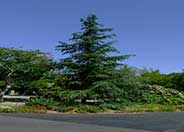
Common name:Julia Phelps California Lilac
Botanical name:Ceanothus 'Julia Phelps'
Fast-growing and densely branched with small dark green leaves, this is a great bloomer showing a marvelous display of delicate, dark indigo blue flowers found in round clusters of 1". It is extremely drought tolerant, and must not be overwatered. It does best in well-drained soil with little to no summer water. It attracts hummingbirds, butterflies and beneficial insects.

Common name:Deergrass
Botanical name:Muhlenbergia rigens
The Deergrass is a warm-season perennial that forms dense clumps from the base. The spike-like flower stalks grow 2'-3' tall and this grass has a striking foundation form. The Deergrass is native to California and needs watering once or twice a month after it has been established. The more water it has, the greener it is.

Common name:Toyon
Botanical name:Heteromeles arbutifolia
Toyon is a California native evergreen shrub that grows 8'-15' high and spreading 2'-3'. It has leathery toothed leaves, white summer flowers and clusters of red winter berries. It tolerates full sun or partial shade, heat, smog, wind and heavy or light soils. It is drought tolerant, attracts beneficial insects and hummingbirds.

Common name:Deodar Cedar
Botanical name:Cedrus deodara
Deodar Cedar (Cedrus deodara) is a large, upright, evergreen tree that can mature to 60' tall and 30' wide. When this plant is small in the nursery, it has a nearly perfect Christmas tree shape with weeping branches, making it appear to be a perfect specimen for a small garden. It will quickly outgrow small garden spaces, so it is best to select this specimen tree only when you have a larger garden. This tree is often used in parks and large open spaces due to its size and natural upright habit. If this tree is planted in a location where it can reach its mature size, it will require almost no pruning or fertilizer. However, if it is planted in a location that is too small, a licensed arborist should be hired to maintain it. This tree should be planted at least 10 feet away from any hardscape areas, 20 feet from structures such as houses and buildings, and not near any powerlines. Shrubs and perennials should be planted about five feet away from this tree. It should be irrigated for about 45 minutes once a week when using most in-line drip irrigation systems.

Common name:Centennial Coyote Brush
Botanical name:Baccharis 'Centennial'
This plant is a hybrid that combines a prostrate habit with tolerance for desert conditions. It grows 3' tall and 6' wide. It tolerates heat, sun and frost, maintaining its green appearance.

Common name:Lilac verbena
Botanical name:Verbena lilacina 'De La Mina'
Lilac verbena (Verbena lilacina 'De La Mina') is an adaptable, mounding perennial that produces mounds of delicate green foliage and stunning dark purple blossoms with lavender highlights. The blooms are lightly scented. Though more flowers are on the bush in spring, it blossoms throughout most of the year, making it a very attractive and versatile plant for any flower border, butterfly garden, or patio container. It grows fast to about 2 feet high and spreads to about 4 feet wide. It is evergreen but may be semi-deciduous in summer.

Common name:California Poppy, Golden Poppy
Botanical name:Eschscholzia californica
This small annual (sometimes acts as a perennial) plant will grow to less than 1' tall and has light, small blue green leaves with gold and orange flowers that bloom in spring and summer.
Designer: Bill Butler
Photographer: GardenSoft
Practice grass-cycling by leaving short grass clippings on lawns after mowing, so that nutrients and organic matter are returned to the soil.
Adjust sprinklers to avoid watering sidewalks and driveways.
Remove irrigation water and fertilizer from areas where you don't want weeds to grow.